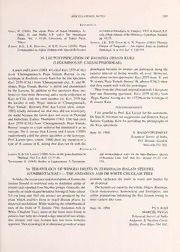
Lectotypification of Bauhinia ornata Kurz (Leguminosae: Caesalpinioideae) PDF
Preview Lectotypification of Bauhinia ornata Kurz (Leguminosae: Caesalpinioideae)
MlSCEl.LANEOUS NOTES 289 References Ohba, H. (1988): The alpine Flora of Nepal Himalaya. In: to Garhwal Himalaya.In: Pangtey, Y.P.S. & Rawal, R.S. Ohba, H. and Malla, S.B. (eds.) The Himalayan (eds.) High Altitudeofthe Himalaya, Gynodaya, Nainital. Plants, Vol. /: 19-26. University of Tokyo Press, pp. 65-75. Tokyo. Skmwal, J.K., R.D. Gaur &—A. N. Purohit (1981): Floristic Rawat, D.S., L.R. Dangwal, & R.D. Gaur (1994): Plant Pattern of Tungnath An Alpine Zone in Garhwal Communities in Alpine Habitat with Speeial Reference Himalaya. Acta hot. Inti. 9: 1 10-1 14. 35. LECTOTYPIFICATION OF BAUHINIA ORNATA KURZ (LEGUMINOSAE: CAESALPINIOIDEAE) Larsen and Larsen (1980: 41) eited Kurz 2579 (CAL) protologue because its ovaries are pubescent along the from ‘Choungmenach, Pegu Yomah, Burma’ as the sutures instead of being woolly all over. However, lectotype of Bciuhinici orncita Kurz but the one specimen observations on two specimens: Kurz 2579 from ‘E. and Kurz 2579 (CAL) from ‘Choungmenah chg., E. and W. W. slopes, Pegu Yomah, Burma’ (K, photos-CAL!) show slopes, Pegu Yomah, Burma’ is sterile and unannot.ated that they match well with the protologue. by the Larsens. In addition to this specimen there are, Thus from the aforesaid original materials I designate however, four more Powering and a sterile collection of here one Powering specimen: Kurz 2579 (CAL) from Kurz in CAL with the same number, i.e. Kurz 2579 but ‘Pegu, Burma’ having acc. no. 1 37296 as the lectotype of the locality is only ‘Pegu’ instead of ‘Choungmenach, B. orncita Kurz. Pegu Yomah’. Recently Prof. Kai Larsen (pers. comm. Acknowledgements 1992) kindly informed me that they did not lectotypify I am grateful to Prof. Kai Larsen for his comments. the name because the taxon does not occur in Thailand Dr. Dan H. Nicolson for suggestions and Director, Royal and Indochina. Earlier, Thothathri (1965: 134) had cited Botanic Gardens, Kew for providing the photographs of Kurz 2579 (CAL) from ‘Choungmenach, Pegu Yomah, the Kew specimens. Burma’ simply as a type material but annotated it as an isotype. So it seems that Larsen and Larsen (1980) •June 16, 1994 S. BANDYOPADHYAY inadvertently cited the above specimen as the lectotype. Botanical Survey of India, Prof. Larsen (pers. comm. 1988) drew my attention to a P.O. Botanic Garden, type of B. orncita in K, noting that does not fit with the Howrah-711 103. RhfhrKNCHS Larshn, K. & S.S. Larsen ( 1980): Notes on thegenusBaithiniain and nomenclatural notes on the Indo-Burmese species Thailand. Thai For. Bull. 13: 37-46. ofBaiiliinia Linn. Bull. Bat. Sac. Bengal 19(2): 130- Thothathri, K. ( 1965): Studies in Leguminosae 5. Taxonomic 134. 36. TERATOLOGY OF WINGED FRUITS IN TERMINAL1A BIALATA STEUDEL — (COMBRETACEAE) THE ANDAMAN ASH OR WHITE CHUGLAM TREE In India, the occurrence and distribution ofTerminalia probably facilitates the fruits to reach still further by bialata Steudel is restricted only to Andaman group of air dispersal. islands (not reported from Nicobargroup). Generally, the The kernels are eaten by the tribals, Onges, Jharawas, butterfly or moth shaped beautiful biwinged fruits (about Great Andamanese, Sentenelese and Shompens, and 5.0 cm long and 10.0 cm across) are produced by the settler populations inhabiting the Bay Islands owing to plant which enables them to reach distant places by their cashew like taste. dispersal mechanism. While studying the ethnobotanical uses of the fruits of T. bialata (The Andaman Ash or June 16, 1994 P.S.N.RAO White Chuglam Tree), some of the fruits were found to MARCELTIGGA possess four fully developed wings instead oftwo wings, Botanical Survey of India this unique and rare feature has not been hitherto Andaman & Nicobar Circle reported. This teratological or abnormal growth of wings Haddo, Port Blair-744 102.
